Graduate
-
 A Volunteer Project by Students: The Surprise Bus!
GoGeeks, one of the undergraduate student clubs at KAIST, plans to run a bus to take volunteers to places where help is needed such as nursing homes, orphanages, and community centers. This volunteer project is called “Surprise Bus!” Students interested in participating in the project can apply online via a social funding website, http://tumblbug.com, until December 5, 2014. Up to 150 students will be selected.
A total of five buses will leave from Seoul on December 20, 2014 to several places nationwide. Participants will not know their final destination until they arrive at the scene where they will work. GoGeeks was inspired by the “Do Good Bus” project, a volunteer organization that started in the US, through which people meet, and while performing their volunteer activities, they get to know each other.
Bum-Kyu Lee, the President of GoGeeks, who is a senior in the Department of Industrial and Systems Engineering, said, “I’ve encountered many students who want to volunteer, but they are not sure where to go to start. The “Surprise Bus!” is a wonderful volunteer opportunity, and I think participants will have fun and, at the same time, will have a meaningful time. The Christmas season is also an excellent time to do something good for our communities and neighborhoods.”
2014.12.04 View 7880
A Volunteer Project by Students: The Surprise Bus!
GoGeeks, one of the undergraduate student clubs at KAIST, plans to run a bus to take volunteers to places where help is needed such as nursing homes, orphanages, and community centers. This volunteer project is called “Surprise Bus!” Students interested in participating in the project can apply online via a social funding website, http://tumblbug.com, until December 5, 2014. Up to 150 students will be selected.
A total of five buses will leave from Seoul on December 20, 2014 to several places nationwide. Participants will not know their final destination until they arrive at the scene where they will work. GoGeeks was inspired by the “Do Good Bus” project, a volunteer organization that started in the US, through which people meet, and while performing their volunteer activities, they get to know each other.
Bum-Kyu Lee, the President of GoGeeks, who is a senior in the Department of Industrial and Systems Engineering, said, “I’ve encountered many students who want to volunteer, but they are not sure where to go to start. The “Surprise Bus!” is a wonderful volunteer opportunity, and I think participants will have fun and, at the same time, will have a meaningful time. The Christmas season is also an excellent time to do something good for our communities and neighborhoods.”
2014.12.04 View 7880 -
 Structure of Neuron-Connecting Synaptic Adhesion Molecules Discovered
A research team has found the three-dimensional structure of synaptic adhesion molecules, which orchestrate synaptogenesis. The research findings also propose the mechanism of synapses in its initial formation. Some brain diseases such as obsessive compulsive disorder (OCD) or bipolar disorders arise from a malfunction of synapses. The team expects the findings to be applied in investigating pathogenesis and developing medicines for such diseases.
The research was conducted by a Master’s candidate Kee Hun Kim, Professor Ji Won Um from Yonsei University, and Professor Beom Seok Park from Eulji University under the guidance of Professor Homin Kim from the Graduate School of Medical Science and Engineering, KAIST, and Professor Jaewon Ko from Yonsei University. Sponsored by the Ministry of Science, ICT and Future Planning and the National Research Foundation of Korea, the research findings were published online in the November 14th issue of Nature Communications.
A protein that exists in the neuronal transmembrane, Slitrk, interacts with the presynaptic leukocyte common antigen-related receptor protein tyrosine phosphatases (LAR-RPTPs) and forms a protein complex. It is involved in the development of synapses in the initial stage, and balances excitatory and inhibitory signals of neurons.
It is known that a disorder in those two proteins cause a malfunction of synapses, resulting in neuropsychosis such as autism, epilepsy, OCD, and bipolar disorders. However, because the structure as well as synaptogenic function of these proteins were not understood, the development of cures could not progress.
The research team discovered the three-dimensional structure of two synaptic adhesion molecules like Slitrk and LAR-RPTPs and identified the regions of interaction through protein crystallography and transmission electron microscopy (TEM). Furthermore, they found that the formation of the synapse is induced after the combination of two synaptic adhesion molecules develops a cluster.
Professor Kim said, “The research findings will serve as a basis of understanding the pathogenesis of brain diseases which arises from a malfunction of synaptic adhesion molecules. In particular, this is a good example in which collaboration between structural biology and neurobiology has led to a fruitful result.” Professor Ko commented that “this will give new directions to synaptic formation-related-researches by revealing the molecular mechanism of synaptic adhesion molecules.”
Figure 1: Overview of the PTPd Ig1–3/Slitrk1 LRR1 complex.
Figure 2: Representative negative-stained electron microscopy images of Slitrk1 Full ectodomain (yellow arrows indicate the horseshoe-shaped LRR domains). The typical horseshoe-shaped structures and the randomness of the relative positions of each LRR domain can be observed from the two-dimensional class averages displayed in the orange box.
Figure 3: Model of the two-step presynaptic differentiation process mediated by the biding of Slitrks to LAR-RPTPs and subsequent lateral assembly of trans-synaptic LAR-RPTPs/Slitrik complexes.
2014.11.28 View 12798
Structure of Neuron-Connecting Synaptic Adhesion Molecules Discovered
A research team has found the three-dimensional structure of synaptic adhesion molecules, which orchestrate synaptogenesis. The research findings also propose the mechanism of synapses in its initial formation. Some brain diseases such as obsessive compulsive disorder (OCD) or bipolar disorders arise from a malfunction of synapses. The team expects the findings to be applied in investigating pathogenesis and developing medicines for such diseases.
The research was conducted by a Master’s candidate Kee Hun Kim, Professor Ji Won Um from Yonsei University, and Professor Beom Seok Park from Eulji University under the guidance of Professor Homin Kim from the Graduate School of Medical Science and Engineering, KAIST, and Professor Jaewon Ko from Yonsei University. Sponsored by the Ministry of Science, ICT and Future Planning and the National Research Foundation of Korea, the research findings were published online in the November 14th issue of Nature Communications.
A protein that exists in the neuronal transmembrane, Slitrk, interacts with the presynaptic leukocyte common antigen-related receptor protein tyrosine phosphatases (LAR-RPTPs) and forms a protein complex. It is involved in the development of synapses in the initial stage, and balances excitatory and inhibitory signals of neurons.
It is known that a disorder in those two proteins cause a malfunction of synapses, resulting in neuropsychosis such as autism, epilepsy, OCD, and bipolar disorders. However, because the structure as well as synaptogenic function of these proteins were not understood, the development of cures could not progress.
The research team discovered the three-dimensional structure of two synaptic adhesion molecules like Slitrk and LAR-RPTPs and identified the regions of interaction through protein crystallography and transmission electron microscopy (TEM). Furthermore, they found that the formation of the synapse is induced after the combination of two synaptic adhesion molecules develops a cluster.
Professor Kim said, “The research findings will serve as a basis of understanding the pathogenesis of brain diseases which arises from a malfunction of synaptic adhesion molecules. In particular, this is a good example in which collaboration between structural biology and neurobiology has led to a fruitful result.” Professor Ko commented that “this will give new directions to synaptic formation-related-researches by revealing the molecular mechanism of synaptic adhesion molecules.”
Figure 1: Overview of the PTPd Ig1–3/Slitrk1 LRR1 complex.
Figure 2: Representative negative-stained electron microscopy images of Slitrk1 Full ectodomain (yellow arrows indicate the horseshoe-shaped LRR domains). The typical horseshoe-shaped structures and the randomness of the relative positions of each LRR domain can be observed from the two-dimensional class averages displayed in the orange box.
Figure 3: Model of the two-step presynaptic differentiation process mediated by the biding of Slitrks to LAR-RPTPs and subsequent lateral assembly of trans-synaptic LAR-RPTPs/Slitrik complexes.
2014.11.28 View 12798 -
 Elsevier Selects a KAIST Graduate's Paper as the Top Cited Papers in 2011-2012
Dr. Myung-Won Seo, a graduate from the Department of Chemical and Bimolecular Engineering at KAIST, published a paper in January 2011 in Chemical Engineering Journal, which was entitled “Solid Circulation and Loop-seal Characteristics of a Dual Circulating Fluidized Bed: Experiments and CFD Simulation.” His paper was selected by Elsevier as the Top Cited Papers of 2011-2012. The Chemical Engineering Journal is a renowned peer-reviewed journal issued by Elsevier.
Dr. Seo published another paper, “CFD Simulation with Experiments in a Dual Circulating Fluidized Bed Gasifier,” in January 2012 in Computers & Chemical Engineering, which was also selected as the Most Downloaded Papers in 2012-2013.
Dr. Seo graduated with a doctoral degree from KAIST in 2011. He is currently working at the Clean Fuel Laboratory, the Korea Institute of Energy Research, Daejeon, as a researcher. His research areas are coal gasification, upgrading, and liquefaction, as well as energy and chemical production from low-grade fuels such as biomass and wastes.
2014.11.24 View 10543
Elsevier Selects a KAIST Graduate's Paper as the Top Cited Papers in 2011-2012
Dr. Myung-Won Seo, a graduate from the Department of Chemical and Bimolecular Engineering at KAIST, published a paper in January 2011 in Chemical Engineering Journal, which was entitled “Solid Circulation and Loop-seal Characteristics of a Dual Circulating Fluidized Bed: Experiments and CFD Simulation.” His paper was selected by Elsevier as the Top Cited Papers of 2011-2012. The Chemical Engineering Journal is a renowned peer-reviewed journal issued by Elsevier.
Dr. Seo published another paper, “CFD Simulation with Experiments in a Dual Circulating Fluidized Bed Gasifier,” in January 2012 in Computers & Chemical Engineering, which was also selected as the Most Downloaded Papers in 2012-2013.
Dr. Seo graduated with a doctoral degree from KAIST in 2011. He is currently working at the Clean Fuel Laboratory, the Korea Institute of Energy Research, Daejeon, as a researcher. His research areas are coal gasification, upgrading, and liquefaction, as well as energy and chemical production from low-grade fuels such as biomass and wastes.
2014.11.24 View 10543 -
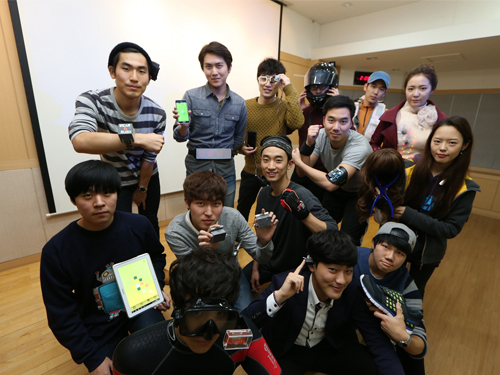 The 2014 Wearable Computer Competition Takes Place at KAIST
“This is a smart wig for patients who are reluctant to go outdoors because their hair is falling out from cancer treatment.”
A graduate student from Sungkyunkwan University, Jee-Hoon Lee enthusiastically explains his project at the KAIST KI Building where the 2014 Wearable Computer Competition was held. He said, “The sensor embedded inside the wig monitors the heart rate and the body temperature, and during an emergency, the device warns the patient about the situation. The product emphasizes two aspects; it notifies the patient in emergency situations, and it encourages patients to perform outdoor activities by enhancing their looks.”
The the tenth anniversary meeting of the 2014 Wearable Computer Competition took place at the KAIST campus on November 13-14, 2014.
A wearable computer is a mobile device designed to be put on the body or clothes so that a user can comfortably use it while walking. Recently, these devices that are able to support versatile internet-based services through smartphones are receiving a great deal of attention.
Wearable devices have been employed in two categorizes: health checks and information-entertainment. In this year’s competition, six healthcare products and nine information-entertainment products were exhibited.
Among these products, participants favored a smart helmet for motorcycle drivers. The driver can see through a rear camera with a navigation screen of the smartphone and text messages through the screen installed in the front glass of the helmet. Another product included a uniform that can control presentation slides by means of motion detection and voice recognition technology. Yet another popular device offered an insole to guide travelers to their destination with the help of motion sensors.
The chairman of the competition, Professor Hoi-Jun Yoo from the Department of Electrical Engineering at KAIST said, “Wearable devices such as smart watches, glasses, and clothes are gaining interest these days. Through this event, people will have a chance to look at the creativity of our students through the display of their wearable devices. In turn, these devices will advance computer technology.”
The third annual wearable computer workshop on convergence technology of wearable computers followed the competition. In the workshop, experts from leading information technology companies such as Samsung Electronics, LG Electronics, and KT Corporation addressed the convergence technology of wearable computers and trends in the field.
2014.11.19 View 11253
The 2014 Wearable Computer Competition Takes Place at KAIST
“This is a smart wig for patients who are reluctant to go outdoors because their hair is falling out from cancer treatment.”
A graduate student from Sungkyunkwan University, Jee-Hoon Lee enthusiastically explains his project at the KAIST KI Building where the 2014 Wearable Computer Competition was held. He said, “The sensor embedded inside the wig monitors the heart rate and the body temperature, and during an emergency, the device warns the patient about the situation. The product emphasizes two aspects; it notifies the patient in emergency situations, and it encourages patients to perform outdoor activities by enhancing their looks.”
The the tenth anniversary meeting of the 2014 Wearable Computer Competition took place at the KAIST campus on November 13-14, 2014.
A wearable computer is a mobile device designed to be put on the body or clothes so that a user can comfortably use it while walking. Recently, these devices that are able to support versatile internet-based services through smartphones are receiving a great deal of attention.
Wearable devices have been employed in two categorizes: health checks and information-entertainment. In this year’s competition, six healthcare products and nine information-entertainment products were exhibited.
Among these products, participants favored a smart helmet for motorcycle drivers. The driver can see through a rear camera with a navigation screen of the smartphone and text messages through the screen installed in the front glass of the helmet. Another product included a uniform that can control presentation slides by means of motion detection and voice recognition technology. Yet another popular device offered an insole to guide travelers to their destination with the help of motion sensors.
The chairman of the competition, Professor Hoi-Jun Yoo from the Department of Electrical Engineering at KAIST said, “Wearable devices such as smart watches, glasses, and clothes are gaining interest these days. Through this event, people will have a chance to look at the creativity of our students through the display of their wearable devices. In turn, these devices will advance computer technology.”
The third annual wearable computer workshop on convergence technology of wearable computers followed the competition. In the workshop, experts from leading information technology companies such as Samsung Electronics, LG Electronics, and KT Corporation addressed the convergence technology of wearable computers and trends in the field.
2014.11.19 View 11253 -
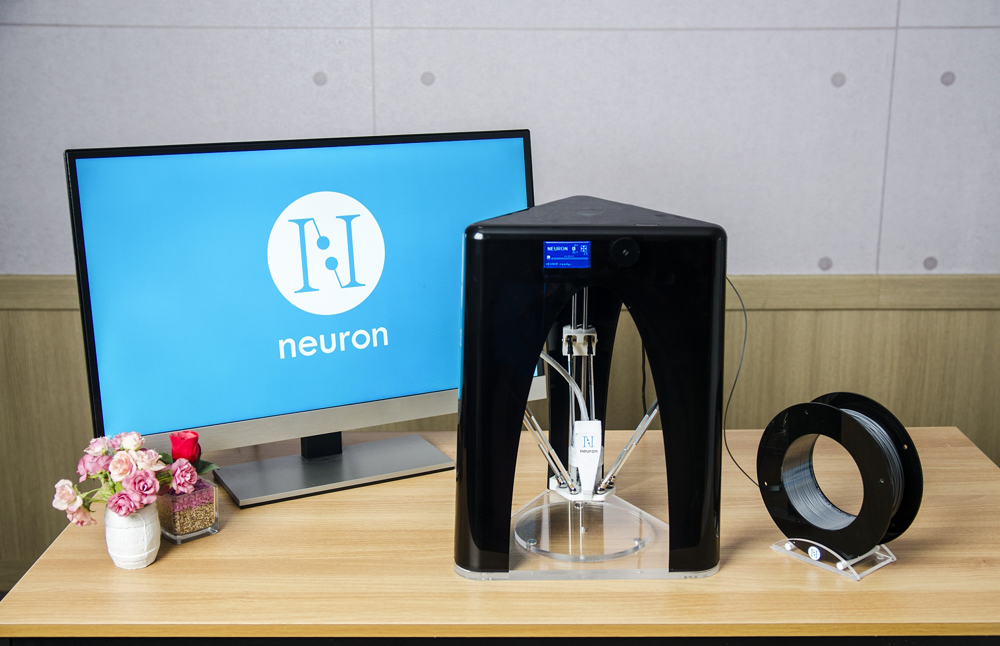 3D Printer Developed by KAIST Undergraduate Students
More than 100 Pre-orders Prior to Product Launch Made
KAIST undergraduate students received more than 100 pre-orders before the launch for 3D printers they developed and became a hot topic of interest.
KAIST Research Institute for Social Technology and Innovations (Head Hong-Kyu Lee) had a launch party at Daejeon Riviera Hotel on 17 November 2014 for “Commercial Delta 3D Printer” developed by KAIST undergraduate students inviting around 50 businesses, buyers and representatives of 3D Printing Industry Association.
“3D Printer” uses blueprints of products such as toys, mug cups and chairs to make 3D objects and is thought to be revolutionary technology in manufacturing industry. The interest has grown as recent printers could print even fruits and cosmetics.
The printing structure of 3D printer can be divided roughly into horizontal Mendel method and Delta method. KAIST students focused on the Delta method to give a differentiated product from 90% of commercial products that use Mendel method.
First, the students focused on lowering the cost of unit price by using self-developed components. The carriage (transport machine) of the product is replaced by self-developed components instead of bearing to reduce the noise and the linking method was changed to beads from loop guide to increase the completeness of the printed product. Also, an auto-levelling is loaded to ensure the nozzle and the bed is parallel and hence increasing convenience for the users. Further, the printer, designed by a product designer in Germany, is linked to a smartphone application for blueprints.
A student in the development team, Seokhyeon Seo (Department of Computer Science, 3rd Year Undergraduate) said, “The biggest merits of the product are lowering the price to a 1/3 by using self-developed components and reducing the noise.” He continued, “By using a smartphone application, anyone can easily design the product. So it is applicable to use for education or at home”
In the exhibit, “3D Printing Korea 2014,” in Coex, Seoul the printer had a preview demonstration, and received more than 100 pre-orders from educational and business training institutions. Further, buyers from Canada and the US requested opening agencies in their countries.
KAIST Research Institute for Social Technology and Innovations Head Hong-Kyu Lee said, “3D printing is an innovative technology that could bring the 3rd industrial revolution.” He continued, “It is still early days but the demand will increase exponentially.”
This project was a research project of KAIST Research Institute for Social Technology and Innovations led by a development team consisting of 4 undergraduate students of KAIST, one student from University of Oxford and one German product designer.
Students in the picture below are Won-Hoi Kim (Department of Mechanical Engineering), Sung-Hyun Cho (Department of Mechanical Engineering), and Suk-Hyun Seo (Department of Computer Science) from left to right.
2014.11.19 View 11738
3D Printer Developed by KAIST Undergraduate Students
More than 100 Pre-orders Prior to Product Launch Made
KAIST undergraduate students received more than 100 pre-orders before the launch for 3D printers they developed and became a hot topic of interest.
KAIST Research Institute for Social Technology and Innovations (Head Hong-Kyu Lee) had a launch party at Daejeon Riviera Hotel on 17 November 2014 for “Commercial Delta 3D Printer” developed by KAIST undergraduate students inviting around 50 businesses, buyers and representatives of 3D Printing Industry Association.
“3D Printer” uses blueprints of products such as toys, mug cups and chairs to make 3D objects and is thought to be revolutionary technology in manufacturing industry. The interest has grown as recent printers could print even fruits and cosmetics.
The printing structure of 3D printer can be divided roughly into horizontal Mendel method and Delta method. KAIST students focused on the Delta method to give a differentiated product from 90% of commercial products that use Mendel method.
First, the students focused on lowering the cost of unit price by using self-developed components. The carriage (transport machine) of the product is replaced by self-developed components instead of bearing to reduce the noise and the linking method was changed to beads from loop guide to increase the completeness of the printed product. Also, an auto-levelling is loaded to ensure the nozzle and the bed is parallel and hence increasing convenience for the users. Further, the printer, designed by a product designer in Germany, is linked to a smartphone application for blueprints.
A student in the development team, Seokhyeon Seo (Department of Computer Science, 3rd Year Undergraduate) said, “The biggest merits of the product are lowering the price to a 1/3 by using self-developed components and reducing the noise.” He continued, “By using a smartphone application, anyone can easily design the product. So it is applicable to use for education or at home”
In the exhibit, “3D Printing Korea 2014,” in Coex, Seoul the printer had a preview demonstration, and received more than 100 pre-orders from educational and business training institutions. Further, buyers from Canada and the US requested opening agencies in their countries.
KAIST Research Institute for Social Technology and Innovations Head Hong-Kyu Lee said, “3D printing is an innovative technology that could bring the 3rd industrial revolution.” He continued, “It is still early days but the demand will increase exponentially.”
This project was a research project of KAIST Research Institute for Social Technology and Innovations led by a development team consisting of 4 undergraduate students of KAIST, one student from University of Oxford and one German product designer.
Students in the picture below are Won-Hoi Kim (Department of Mechanical Engineering), Sung-Hyun Cho (Department of Mechanical Engineering), and Suk-Hyun Seo (Department of Computer Science) from left to right.
2014.11.19 View 11738 -
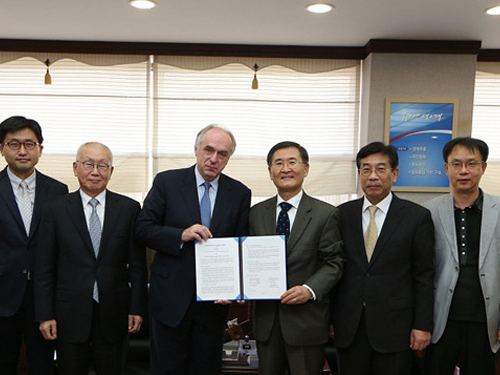 KAIST and the International Institute for Applied Systems Analysis Agree to Cooperate
KAIST signed a cooperation agreement with the International Institute for Applied Systems Analysis (IIASA) on October 29, 2014 at the president’s office.
Established in 1972 and based in Austria as a non-governmental research organization, IIASA is an international scientific institute that conducts policy-oriented research into global problems such as climate change, energy security, or population aging. IIASA examines such issues and devises strategies for cooperative action unconstrained by political and national self-interest.
Dr. Pavel Kabat, the Director General and CEO of IIASA, headed a delegation that visited KAIST to attend the signing ceremony of the agreement. He said, “KAIST has been known as a leading research university, and its strength in the development of green technology and environmental policy will benefit our institution. In particular, we expect to see vibrant exchanges of knowledge and researchers with the Graduate School of Green Growth (GSGG) and the Graduate School of EEWS (energy, environment, water, and sustainability) at KAIST.”
The two organizations will implement joint research projects in the diffusion analysis of green technology, the development and improvement of evaluation models to integrate economy, energy, and environment, the development of an analysis system for water resources, and the establishment of academic workshops and conferences.
The Dean of GSGG, Professor Jae-Kyu Lee said, “IIASA is a well-respected international organization with accumulated knowledge about analysis and prediction techniques. With this agreement, we hope that KAIST will intensify its research capacity in environmental science and lead education and research in green growth and environmental technology.”
The picture below shows Dr. Pavel Kabat, the Director General and CEO of IIASA, on the left and President Steve Kang of KAIST on the right holding the signed agreement with professors from GSGG and EEWS Graduate School including Professor Jae-Kyu Lee, to the right of President Kang.
2014.11.05 View 11250
KAIST and the International Institute for Applied Systems Analysis Agree to Cooperate
KAIST signed a cooperation agreement with the International Institute for Applied Systems Analysis (IIASA) on October 29, 2014 at the president’s office.
Established in 1972 and based in Austria as a non-governmental research organization, IIASA is an international scientific institute that conducts policy-oriented research into global problems such as climate change, energy security, or population aging. IIASA examines such issues and devises strategies for cooperative action unconstrained by political and national self-interest.
Dr. Pavel Kabat, the Director General and CEO of IIASA, headed a delegation that visited KAIST to attend the signing ceremony of the agreement. He said, “KAIST has been known as a leading research university, and its strength in the development of green technology and environmental policy will benefit our institution. In particular, we expect to see vibrant exchanges of knowledge and researchers with the Graduate School of Green Growth (GSGG) and the Graduate School of EEWS (energy, environment, water, and sustainability) at KAIST.”
The two organizations will implement joint research projects in the diffusion analysis of green technology, the development and improvement of evaluation models to integrate economy, energy, and environment, the development of an analysis system for water resources, and the establishment of academic workshops and conferences.
The Dean of GSGG, Professor Jae-Kyu Lee said, “IIASA is a well-respected international organization with accumulated knowledge about analysis and prediction techniques. With this agreement, we hope that KAIST will intensify its research capacity in environmental science and lead education and research in green growth and environmental technology.”
The picture below shows Dr. Pavel Kabat, the Director General and CEO of IIASA, on the left and President Steve Kang of KAIST on the right holding the signed agreement with professors from GSGG and EEWS Graduate School including Professor Jae-Kyu Lee, to the right of President Kang.
2014.11.05 View 11250 -
 KAIST and Petersburg State Transport University Sign a MOU on Green Transportation
The Petersburg State Transport University (PSTU) in Russia is a higher education institution specializing in railway transport.
KAIST and PSTU signed a memorandum of understating (MOU) on October 28, 2014 at the KAIST campus and agreed to collaborate in the research of and hold academic exchanges for green transportation.
Based on the agreement, the two institutions will collaborate in the development of a high capacity railway that is powered through wireless power transfer technology and will exchange personnel and academic knowledge to advance the field of green transportation.
The Graduate School for Green Transportation (GSGT) at KAIST organized a seminar which took place after the MOU signing ceremony. Professor Dong-Ho Cho, the Dean of GSGT, presented a keynote speech at the seminar on “Korea’s Green Transportation Policy and Its Technology Development Status” to the audience including the PSTU delegation.
Established in 1809, PSTU is one of the oldest and most prestigious engineering universities in Russia, serving as an important scientific and research center in the area of engineering, construction, and railway operation.
2014.11.04 View 9842
KAIST and Petersburg State Transport University Sign a MOU on Green Transportation
The Petersburg State Transport University (PSTU) in Russia is a higher education institution specializing in railway transport.
KAIST and PSTU signed a memorandum of understating (MOU) on October 28, 2014 at the KAIST campus and agreed to collaborate in the research of and hold academic exchanges for green transportation.
Based on the agreement, the two institutions will collaborate in the development of a high capacity railway that is powered through wireless power transfer technology and will exchange personnel and academic knowledge to advance the field of green transportation.
The Graduate School for Green Transportation (GSGT) at KAIST organized a seminar which took place after the MOU signing ceremony. Professor Dong-Ho Cho, the Dean of GSGT, presented a keynote speech at the seminar on “Korea’s Green Transportation Policy and Its Technology Development Status” to the audience including the PSTU delegation.
Established in 1809, PSTU is one of the oldest and most prestigious engineering universities in Russia, serving as an important scientific and research center in the area of engineering, construction, and railway operation.
2014.11.04 View 9842 -
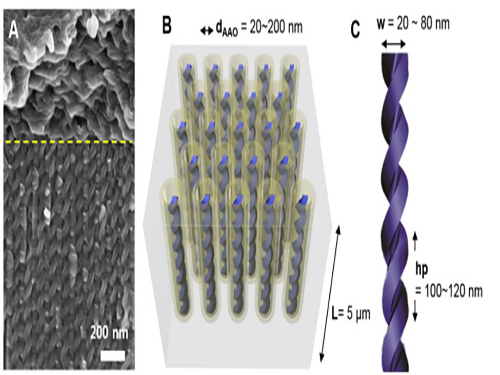 KAIST Develops Core Technology to Synthesize a Helical Nanostructure
Professor Dong-Ki Yoon’s research team of the Graduate School of Nanoscience and Technology (GSNT) at KAIST has developed helical nanostructures using self-assembly processes. The results were published in the Proceedings of the National Academy of Sciences of the United States of America(PNAS) on the October 7th.
This technology enables the synthesis of various helical structures on a relatively large confined area. Its synthesis is often considered the most arduous for three dimensional structures. Formed from liquid crystal, the structure holds a regular helical structure within the confined space of 20 to 300 nanometers. Also, the distance between each pattern increased as the diameter of the nanostructure increased.
Liquid crystals have a unique property of responding sensitively to the surrounding electromagnetic field. The technology, in combination with the electromagnetic property of liquid crystal, is expected to foster the development of highly efficient optoelectronic devices.
Using this technology, it is possible to develop three dimensional patterning technology beyond the current semiconductor manufacturing technology which uses two dimensional photolithography processes. Three-dimensional semiconductor devices are expected to store hundred times more data than current devices. They will also lower costs by simplifying manufacturing processes.
The essence of this research, “self-assembly in confined space,” refers to controlling complex nanostructures, which can be synthesized from materials such as macromolecules, liquid crystal molecules, and biomolecules in relation to surrounding environments including the temperature, concentration, and pH.
The research team produced a confined space with a length of tens of nanometers by using a porous anodized aluminum membrane induced from an electrochemical reaction. They successfully synthesized independently controlled helical nanostructures by forming the helical structures from liquid crystal molecules within that space.
Professor Yoon said, “This research examines the physicochemical principle of controlling helical nanostructures.” He highlighted the significance of the research and commented, “The technology enables the control of complex nanostructures from organic molecules by using confined space and surface reforming.”
He added that, “When grafted with nanotechnology or information technology, this technology will spur new growth to liquid crystal-related industries such as the LCD.”
The research was led by two Ph.D. candidates, Hanim Kim and Sunhee Lee, under the guidance of Professor Yoon. Dr. Tae-Joo Shin of the Pohang Accelerator Laboratory, Professor Sang-Bok Lee of the University of Maryland, and Professor Noel Clark of the University of Colorado also participated.
Picture 1. Electron Microscopy Pictures and Conceptual Diagrams of Helical Nanostructures
Picture 2. Electron Microscopy Pictures of Manufactured Helical Nanostructures
2014.10.29 View 9568
KAIST Develops Core Technology to Synthesize a Helical Nanostructure
Professor Dong-Ki Yoon’s research team of the Graduate School of Nanoscience and Technology (GSNT) at KAIST has developed helical nanostructures using self-assembly processes. The results were published in the Proceedings of the National Academy of Sciences of the United States of America(PNAS) on the October 7th.
This technology enables the synthesis of various helical structures on a relatively large confined area. Its synthesis is often considered the most arduous for three dimensional structures. Formed from liquid crystal, the structure holds a regular helical structure within the confined space of 20 to 300 nanometers. Also, the distance between each pattern increased as the diameter of the nanostructure increased.
Liquid crystals have a unique property of responding sensitively to the surrounding electromagnetic field. The technology, in combination with the electromagnetic property of liquid crystal, is expected to foster the development of highly efficient optoelectronic devices.
Using this technology, it is possible to develop three dimensional patterning technology beyond the current semiconductor manufacturing technology which uses two dimensional photolithography processes. Three-dimensional semiconductor devices are expected to store hundred times more data than current devices. They will also lower costs by simplifying manufacturing processes.
The essence of this research, “self-assembly in confined space,” refers to controlling complex nanostructures, which can be synthesized from materials such as macromolecules, liquid crystal molecules, and biomolecules in relation to surrounding environments including the temperature, concentration, and pH.
The research team produced a confined space with a length of tens of nanometers by using a porous anodized aluminum membrane induced from an electrochemical reaction. They successfully synthesized independently controlled helical nanostructures by forming the helical structures from liquid crystal molecules within that space.
Professor Yoon said, “This research examines the physicochemical principle of controlling helical nanostructures.” He highlighted the significance of the research and commented, “The technology enables the control of complex nanostructures from organic molecules by using confined space and surface reforming.”
He added that, “When grafted with nanotechnology or information technology, this technology will spur new growth to liquid crystal-related industries such as the LCD.”
The research was led by two Ph.D. candidates, Hanim Kim and Sunhee Lee, under the guidance of Professor Yoon. Dr. Tae-Joo Shin of the Pohang Accelerator Laboratory, Professor Sang-Bok Lee of the University of Maryland, and Professor Noel Clark of the University of Colorado also participated.
Picture 1. Electron Microscopy Pictures and Conceptual Diagrams of Helical Nanostructures
Picture 2. Electron Microscopy Pictures of Manufactured Helical Nanostructures
2014.10.29 View 9568 -
 Parents of Alumni Donates to KAIST
Parents of KAIST alumni donated a scholarship of USD 4,800 to the university. A donation ceremony took place at the president’s office on October 21, 2014.
Two sons and the daughter-in-law of Ki-Hong Oh (husband) and Soon-Yi Kim (wife) studied at KAIST. Hwan-Hee Oh and Hwan-Yup Oh graduated with Master’s degrees in Mechanical Engineering in 2005 and 2009, respectively. Jung-Im Min received a Ph.D. in Mechanical Engineering in 2005.
Oh and Kim, who are orange growers in Jeju Island, Korea, said, “We have always appreciated the generous support our children received from KAIST and thought for many years about ways to make a contribution to the development of the university. Although this is a small amount, we are pleased to express our appreciation to KAIST.”
The couple hope that their donation will inspire others in Korea to follow suit and added, “Just like many of the great universities in the west which are supported through donations made by their alumni and people from all walks of life, we would like to see Korean universities also benefit from such a culture and practice.”
President Steve Kang expressed his gratitude to the couple and said, “KAIST will cherish your philanthropic good deeds, and the scholarship will be used to support students as you wish.”
2014.10.22 View 9300
Parents of Alumni Donates to KAIST
Parents of KAIST alumni donated a scholarship of USD 4,800 to the university. A donation ceremony took place at the president’s office on October 21, 2014.
Two sons and the daughter-in-law of Ki-Hong Oh (husband) and Soon-Yi Kim (wife) studied at KAIST. Hwan-Hee Oh and Hwan-Yup Oh graduated with Master’s degrees in Mechanical Engineering in 2005 and 2009, respectively. Jung-Im Min received a Ph.D. in Mechanical Engineering in 2005.
Oh and Kim, who are orange growers in Jeju Island, Korea, said, “We have always appreciated the generous support our children received from KAIST and thought for many years about ways to make a contribution to the development of the university. Although this is a small amount, we are pleased to express our appreciation to KAIST.”
The couple hope that their donation will inspire others in Korea to follow suit and added, “Just like many of the great universities in the west which are supported through donations made by their alumni and people from all walks of life, we would like to see Korean universities also benefit from such a culture and practice.”
President Steve Kang expressed his gratitude to the couple and said, “KAIST will cherish your philanthropic good deeds, and the scholarship will be used to support students as you wish.”
2014.10.22 View 9300 -
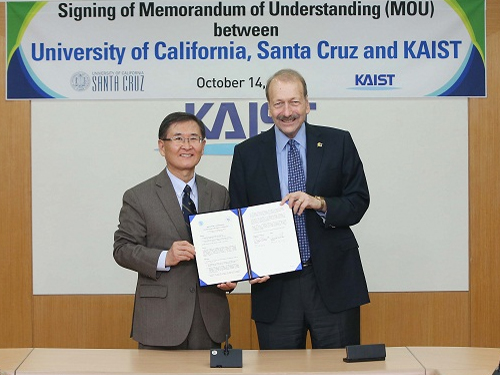 KAIST and University of California, Santa Cruz, Agree to Cooperate
KAIST and the University of California in Santa Cruz signed a memorandum of understanding (MOU) at the KAIST campus on October 14, 2014.
The two institutions agreed to cooperate in the following four areas:
- Research collaboration in genomics and biology
- Academic exchanges in engineering and information communication technology
- Student and faculty exchange programs
- Joint academic workshops and seminars
Following the MOU signing ceremony, Dr. George Blumenthal, the Chancellor of UC Santa Cruz, held a special seminar for KAIST students and faculty, during which he shared some of the success stories made through UC Santa Cruz’s close cooperation with companies in Silicon Valley.
President Steve Kang of KAIST praised the MOU saying, “KAIST and UC Santa Cruz have top-notch research professionals, and the MOU will reinforce their research capability. We hope that the two universities will carry out many research projects that bring significant impact on the world.”
UC Santa Cruz was established in 1965 as a public research university committed to undergraduate education. The university has a total student population of 16,000 (15,375 undergraduates and 1,378 graduates). Offering 60 undergraduate majors, UC Santa Cruz's faculty includes six recipients of Pulitzer Prizes and five MacArthur Genius Awards. The university was ranked the 2nd in the world for research influence in 2012-2013 Times Higher Education rankings.
2014.10.15 View 8935
KAIST and University of California, Santa Cruz, Agree to Cooperate
KAIST and the University of California in Santa Cruz signed a memorandum of understanding (MOU) at the KAIST campus on October 14, 2014.
The two institutions agreed to cooperate in the following four areas:
- Research collaboration in genomics and biology
- Academic exchanges in engineering and information communication technology
- Student and faculty exchange programs
- Joint academic workshops and seminars
Following the MOU signing ceremony, Dr. George Blumenthal, the Chancellor of UC Santa Cruz, held a special seminar for KAIST students and faculty, during which he shared some of the success stories made through UC Santa Cruz’s close cooperation with companies in Silicon Valley.
President Steve Kang of KAIST praised the MOU saying, “KAIST and UC Santa Cruz have top-notch research professionals, and the MOU will reinforce their research capability. We hope that the two universities will carry out many research projects that bring significant impact on the world.”
UC Santa Cruz was established in 1965 as a public research university committed to undergraduate education. The university has a total student population of 16,000 (15,375 undergraduates and 1,378 graduates). Offering 60 undergraduate majors, UC Santa Cruz's faculty includes six recipients of Pulitzer Prizes and five MacArthur Genius Awards. The university was ranked the 2nd in the world for research influence in 2012-2013 Times Higher Education rankings.
2014.10.15 View 8935 -
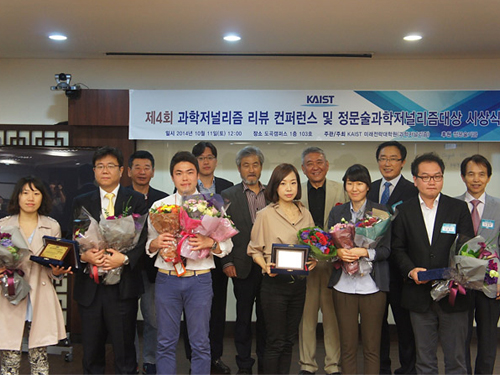 KAIST's Masters of Science Journalism Presents the 4th Annual Moon-Sul Chung Award
The Masters of Science Journalism (MSJ) program at the Graduate School of Future Strategy, KAIST, hosted a conference and presented its fourth annual Moon-Sul Chung Award to the Hankyoreh newspaper at KAIST’s Seoul campus on October 11, 2014.
MSJ organized the conference to review major issues reported in the Korean news in the context of the sciences, for example, how the Korean media covered the tragic accident of the Sewol Ferry, a passenger ship that capsized and eventually sank with hundreds of passengers on board in the waters off the southern coast of Korea on April 16, 2014. Participants of the conference discussed the approaches taken by the media to report science-related issues such as mechanical problems of the ship and technical errors made by the operator.
MSJ conferred its annual award to a Hankyoreh news team which covered the Sewol incident. The award is named for Moon-Sul Chung, a philanthropist who created a scholarship fund for the school in 2011 to recognize news organizations that have striven to report social issues in a fair and balanced manner.
2014.10.14 View 6904
KAIST's Masters of Science Journalism Presents the 4th Annual Moon-Sul Chung Award
The Masters of Science Journalism (MSJ) program at the Graduate School of Future Strategy, KAIST, hosted a conference and presented its fourth annual Moon-Sul Chung Award to the Hankyoreh newspaper at KAIST’s Seoul campus on October 11, 2014.
MSJ organized the conference to review major issues reported in the Korean news in the context of the sciences, for example, how the Korean media covered the tragic accident of the Sewol Ferry, a passenger ship that capsized and eventually sank with hundreds of passengers on board in the waters off the southern coast of Korea on April 16, 2014. Participants of the conference discussed the approaches taken by the media to report science-related issues such as mechanical problems of the ship and technical errors made by the operator.
MSJ conferred its annual award to a Hankyoreh news team which covered the Sewol incident. The award is named for Moon-Sul Chung, a philanthropist who created a scholarship fund for the school in 2011 to recognize news organizations that have striven to report social issues in a fair and balanced manner.
2014.10.14 View 6904 -
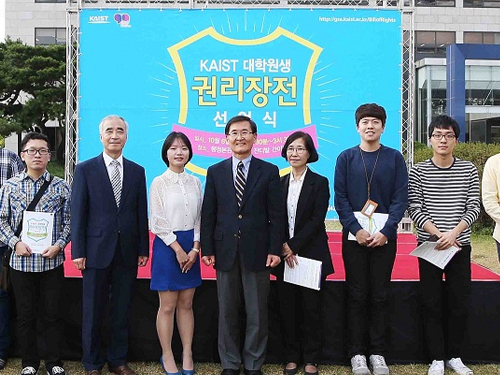 KAIST Introduces a Student Bill of Rights
The Graduate Student Association at KAIST (GSA) established a Bill of Rights for students, outlining student basic beliefs, rights, and obligations. This was the first time for Korean university students to create their own Bill of Rights.
The Bill consists of a total of 21 articles. The preamble of the Bill states individual rights for students, confirming that the Constitution of the Republic of Korea extends to the members of the KAIST community. The Articles stipulate the rights and obligations of students, covering such rights as healthcare, marriage, maternal care, privacy protection, study and research opportunities, and security.
The GSA held a ceremony to inform KAIST members of the Bill of Rights in front of the Main Administration building on October 6, 2014. Approximately 100 students and faculty members, including President Steve Kang, joined the ceremony. They expressed support for students’ efforts to build a better environment conducive to study and research.
Yeon-Ju Kim, the GSA President, said, “The Student Bill of Rights will serve as the first step to raise awareness about our rights and obligations. The Student Association will continue making efforts to provide KAIST students with an opportunity to study and live in a happier and healthier environment.”
2014.10.11 View 6814
KAIST Introduces a Student Bill of Rights
The Graduate Student Association at KAIST (GSA) established a Bill of Rights for students, outlining student basic beliefs, rights, and obligations. This was the first time for Korean university students to create their own Bill of Rights.
The Bill consists of a total of 21 articles. The preamble of the Bill states individual rights for students, confirming that the Constitution of the Republic of Korea extends to the members of the KAIST community. The Articles stipulate the rights and obligations of students, covering such rights as healthcare, marriage, maternal care, privacy protection, study and research opportunities, and security.
The GSA held a ceremony to inform KAIST members of the Bill of Rights in front of the Main Administration building on October 6, 2014. Approximately 100 students and faculty members, including President Steve Kang, joined the ceremony. They expressed support for students’ efforts to build a better environment conducive to study and research.
Yeon-Ju Kim, the GSA President, said, “The Student Bill of Rights will serve as the first step to raise awareness about our rights and obligations. The Student Association will continue making efforts to provide KAIST students with an opportunity to study and live in a happier and healthier environment.”
2014.10.11 View 6814